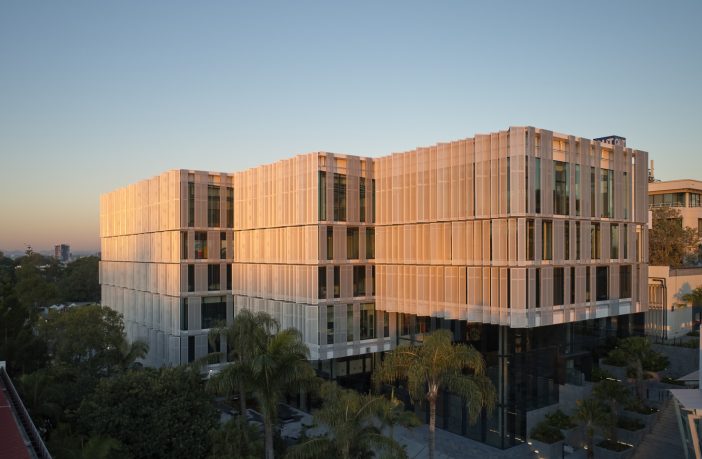Topic: Smart Buildings
- The building gives a new social and academic focal point to campus, a learning environment reflecting the latest innovations in technology, educational philosophy, and sustainability.
On Australia’s sunny eastern coast, a new model of social, sustainable learning has taken shape. The Peter Coaldrake Education Precinct, designed for the Queensland University of Technology by Henning Larsen and Wilson Architects, draws from surrounding campus activity to breathe new life into traditional academic models. The six-level, 11,000 m2 building layers classroom, research, and office facilities atop an airy ground-level atrium, framing upper academic spaces around an active social foundation.
Positioned between the university library and the main thoroughfare in QUT’s Kelvin Grove Campus, the Faculty of Education building extends its atrium to campus traffic, drawing new visitors and encouraging new connections within. The building gives a new social and academic focal point to campus, a learning environment reflecting the latest innovations in technology, educational philosophy, and sustainability. A terraced, landscaped atrium connecting the university library and main road establishes the Faculty of Education as a social conduit on campus, at once a thoroughfare and destination.
Planted green social spaces both indoors and out invite visitors to use the building as a more informal meeting point, creating an active crossroads of campus life. Visible through the glass façade is the luminous form of a LED sphere five meters in diameter, suspended over the atrium floor. The installation, along with wall-mounted displays controllable by students, gives the Faculty of Education building a colorful local identity and embody the University’s commitment to creativity in technology.
As smart technology defines the building’s social and academic spaces, so too has it shaped the building’s fundamental design. Its self-shading, overlapping volumes and angled exterior louvers serve to reduce solar heating within, reducing overall reliance on energy-intensive climate control systems. These sun shading measures are anticipated to reduce its solar heating intake by up to 40 percent, supporting the project’s goal of a Green Star Level 5 sustainability rating from the Green Building Council of Australia.









.jpg?1562727595)
.jpg?1562727347)
.jpg?1562728835)
.jpg?1562728713)
.jpg?1562729212)
.jpg?1562728835)
.jpg?1562727853)
.jpg?1562727347)
.jpg?1562727466)
.jpg?1562727227)
.jpg?1562727084)
.jpg?1562728593)
.jpg?1562728234)
.jpg?1562727722)
.jpg?1562728359)
.jpg?1562728482)
.jpg?1562728958)
.jpg?1562728713)
.jpg?1562729092)
.jpg?1562728531)
_(1).jpg?1562728110)
.jpg?1562727595)
.jpg?1562726791)
.jpg?1562726663)
.jpg?1562726912)





